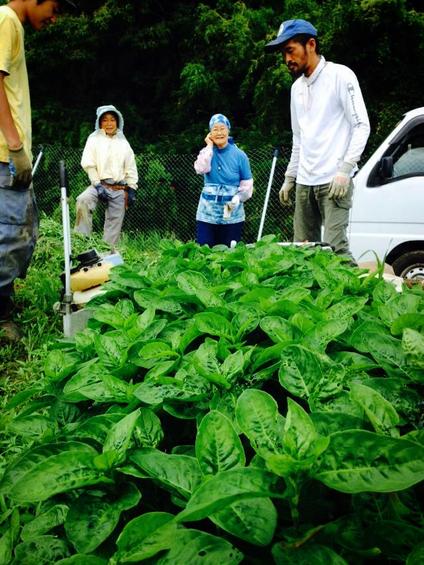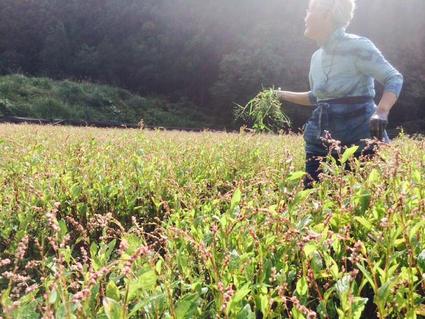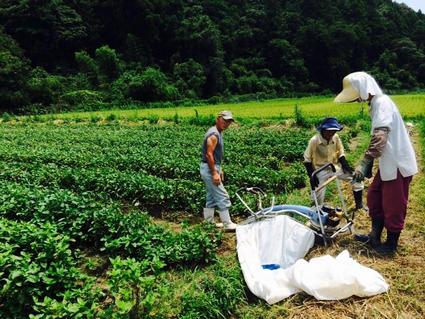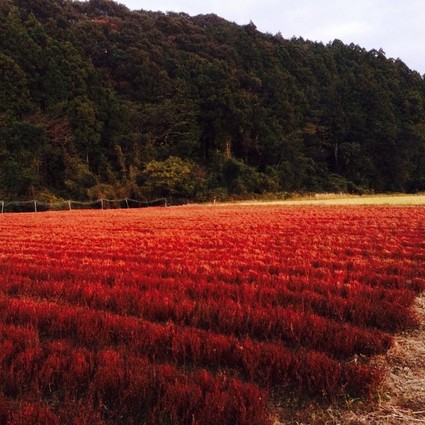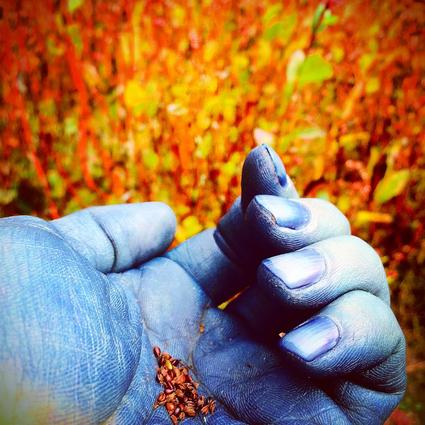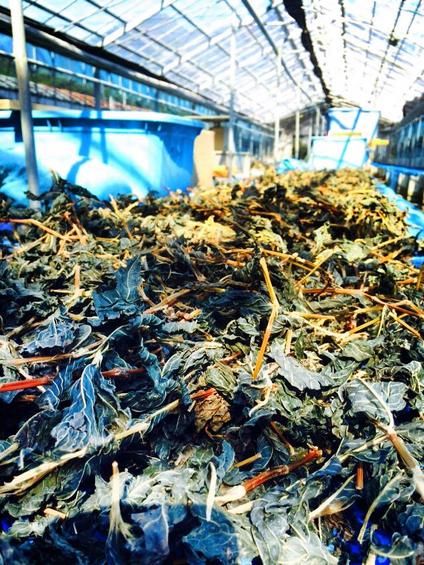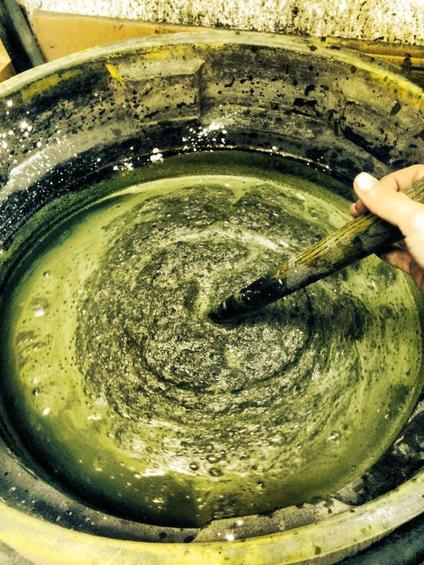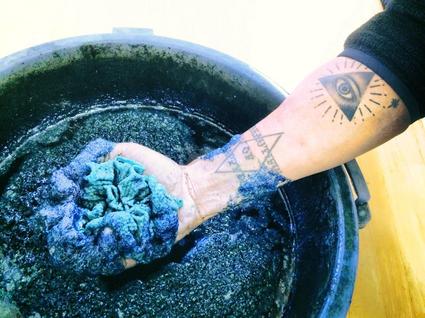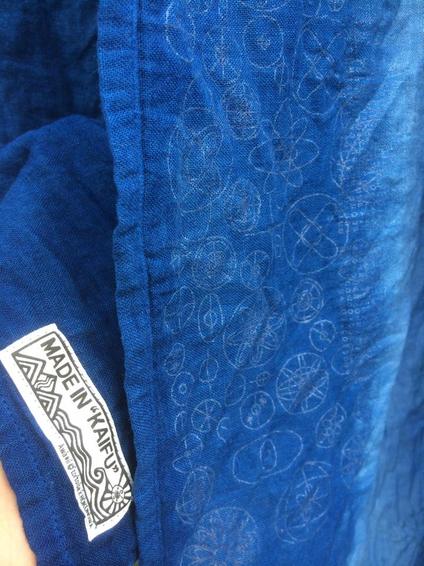3月の終わりから4月の始めにかけて、徳島県海部郡海陽町にある『海部藍』を開発した(株)トータスにて藍染の体験をさせてもらいました。今日はその藍について重要な部分だけお話をしようと思います。後にある人達の協力を得て完成したプロダクトを紹介しようと思っています。まずはJAPAN BLUEと言われている『藍』について少しでも良いので知ってください。
For English speaker, please roll down tiil you see my translation. Thank you.
①藍とは
藍は紀元前4,500年頃のインダス文明の遺跡に藍染め工房が発見されているように、とても深い歴史を持っているとのこと。日本では2世紀頃、中国から蓼藍(たであい)が移植されて藍染めが始まったという説があります。
藍はタデ科の1年草で3月の上旬に苗床に種をまき、苗が20cmくらいに育つと本畑に定植するんだそうです。育った藍は7月から9月の炎天下に刈り取り、収穫された藍は葉と茎に選別され、葉はしっかりと天日乾燥します。この乾燥葉を「藍葉」というそうです。
②すくも灰汁醗酵建て
一般に知られる伝統的な藍染料は「すくも」と呼ばれる醗酵染料です。藍葉を寝床に積み上げ一週間毎に水を打ち、まんべんなくかき混ぜる事で醗酵を促し、この作業を約4ヶ月間続けて完成させます。出来上がった「すくも」に木灰汁、日本酒、石灰などを加えて染色液を建てる製法を「すくも灰汁醗酵建て」といいます。化学染料がスタンダードとなった今ですが、藍の本場阿波徳島を中心に今なお藍師・染師の方々によって先人の智恵・伝統の製法が守り続けられているとのことです。
③海部藍(あまべあい)とは?
(株)トータス(今回藍染め体験、そして色々な事を教えてくれた会社)が薬草としての藍に注目し、農薬不使用の安心安全栽培法を実践するなど、藍草が本来持つ消臭、消炎、抗菌などの効能をより効果的に引き出す方法を追求した末に確立した染色方法、それが「海部藍」です。「すくも」にする工程を省き、乾燥葉をそのまま使用するため、色の濃さや染料の寿命はすくも灰汁醗酵建てには劣るそうですが、人と自然に優しく、誰にでも手軽に気軽に親しめる天然染料として、日々の暮らしに「藍」を取り入れてもらえたらと考えてできあがったのが起源です。
④海部藍の由来
はるか6世紀頃、阿波の国から全国へ衣食住の優れた文化を平和的に広めた忌部族(いむべぞく吉野川流域)と、航海術を駆使し、その活動を支えた海部族(あまべぞく徳島県南部)の歴史にちなみ、海部郡(かいふぐん)より広く世界へ向けた新たな薬草藍染め文化の発信を願い「海部藍」と名付けたそうです。
⑤蓼藍の効能
・毒蛇よけ(ジーンズなど)
・抗菌効果(水虫や足袋に使用)
・遠赤外線効果
・UVカット(UVカット率 98.6%)
・止血、あせも、切り傷に効果
・染色により繊維が丈夫になる効果
・虫除け(ヒルや虫などが寄ってこない効果)
・消臭効果(おむつ、産着、仕事着など)
・漢方薬(解毒、解熱、消炎、やけど、虫さされ、胃炎など)
・温度変化に強い
・皮膚病の伝染を阻止
・青による精神の安定効果
なぜ徳島の藍がここまで盛んになったのかという歴史については以下のリンクを参照してください。
http://www.awanavi.jp/feature/awaai.html
From the end of March till the beginning of April, I had an experience of traditional indigo dye with Tortoise Co., Ltd. which established "AMABE-AI" in Kaifu, Tokushima prefecture. Today, I am going to talk about "AI" first to have you know how it works and its effect.
① What is "Ai" ? in English called "Indigo"
In terms of Indigo, you might think of the same way everywhere in the world does, but it seems that there are at least 9 ways on this planet.
Indigo dyeing studios were found in a ruin of the Indus Valley Civilization, BC 4500. In Japan, there is a theory that people believe it started from around 2nd century by importing indigo, in other word, "TADEAI" from China.
"AI" that we use here in Japan is actually an annual plant, and we start scattering seeds on their bed from the beginning of March. Once they become around 20 cm, they will be delivered to a large field that they can grow up naturally and freely. We are going to reap them between July and September under the blazing summer sun. We sort out leaves and stems, and these leaves will be sun drying and completed as "AIBA".
② "SUKUMO" ash liquid fermentation
"SUKUMO" is generally known as a traditional fermentation indigo dye material. We pile up all the dried leaves on their second bed and sprinkle them with water per week, mixing well and stimulate these dried leaves in order to get fermented nicely. We are going to keep working on this process for 4 months and will be completed. Adding, ash liquid, Japanese sake, and hydrated lime into a finished "SUKUMO" and this method is traditionally called, "Sukumo Ash Liquid Fermentation". Even though a chemical dye is a standard way, this traditional dyeing method and a wisdom are protected by traditional craftsmen, indigo masters, focusing on Awa, TOKUSHIMA prefecture, where is well known for "AI".
③ What is "AMABE-AI" ?
Tortoise Co., Ltd. (http://www.tortoise1897.com/index.html) paid attention to "Ai" as a medical herb and practiced a safe cultivation method without using agricultural chemicals. They established the dyeing technique after pursuing an effect of deodorization, anti-inflammation, and antibacterial, which "Ai" originally carries. This is what is called "AMABE-AI". They skipped a process of "SUKUMO", and use dried leaves as they are, therefore, a color strength and a life of dye are inferior to "Sukumo ash liquid fermentation. However, it is environment friendly and healthy for you. As a natural dye which any of us are easily able to get close to, we deeply think that we would like you to accept "Ai" in your daily life and this is how "AMABE-AI" was born.
④ The origin of AMABE-AI.
AMABE-AI was named after a wish which was about spreading a new medical indigo dye culture to the world from KAIFU county and two histories of AMABE tribe, from southern part in TOKUSHIMA, which knows seamanship and IMUBE tribe, from YOSHINO river, which spreads the culture of food, clothing and shelter toward all over Japan from Awa Country in 6th century.
⑤ The benefits of "Ai".
・Protection against poisonous snakes. (Used in Jeans)
・Antibacterial effect. (For athlete's foot and used for TABI)
・Ultra-red ray effect.
・UV cut. (UV cut percentage is 98.6%)
・Effect for hemostasis, heat rash, and a wound.
・A thread grows stronger after dye.
・An insect repellent. (Effect for leech and all insects)
・A herbal medicine. (Detoxication, alleviation of fever, anti-inflammation, burn, insect bite, and gastritis)
・A strength for heat changes.
・Stop infection of a skin disease.
・Stability of the mind by looking at a color of blue.


